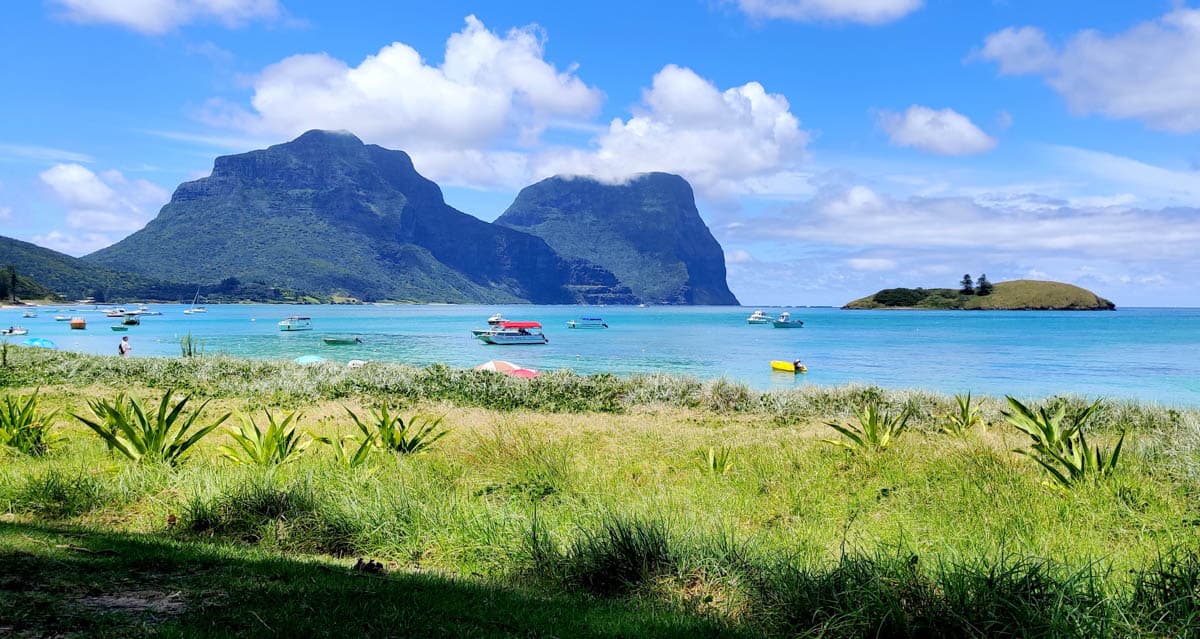
Go World Travel is reader-supported and may earn a commission from purchases made through links in this piece.
Decorated with hibiscus plants in pastel tones of pink, orange and lemon and surrounded by semi-tropical rainforests, our hotel room seemed ensconced in a slice of Eden. Here began another typical island stay. Or so I thought.
I went to lock my hotel room to go grab a bite and realised there was nothing close to a bolt, latch or chain. Popping into the attendant’s office in the next room I asked: ‘There’s no lock?’
‘Why do you need one?’ came an interesting reply. Before I could continue, he nodded reassuringly and grinned. ‘Relax mate, we are all in this island together. It’s one very small place, with one very big family, trust me.’
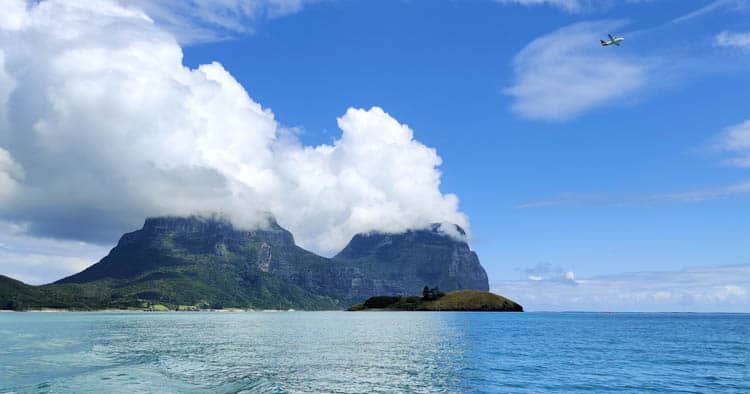
Welcome to Lord Howe Island
Indeed it is small. Lord Howe Island in Australia, LHI for short, is only 11 km long and at most 2 km wide. Yet, this tiny paradise will remind you time and again that good things come in small packages.
Lord Howe Island may be tiny, but historically, LHI’s colonial chronicles are among the oldest in the country.
In 1788 – the same year as Sydney was established – Colonel Henry Lidgbird Ball discovered this island, 600km off the coast of Australia while sailing to Norfolk Island to establish a penal colony.
Thereafter, the island remained uninhabited and served as a pit-stop for whaling ships owing to its abundant supply of flightless birds and freshwater. It was only in the 1830s that three Englishmen, fleeing the destruction of their whaling station in New Zealand by marauding Maoris, came to LHI and established the first human settlement.
Paradise was thus conquered, more by compulsion than by choice. Making it perhaps one of the last islands in the world to be settled by mankind.
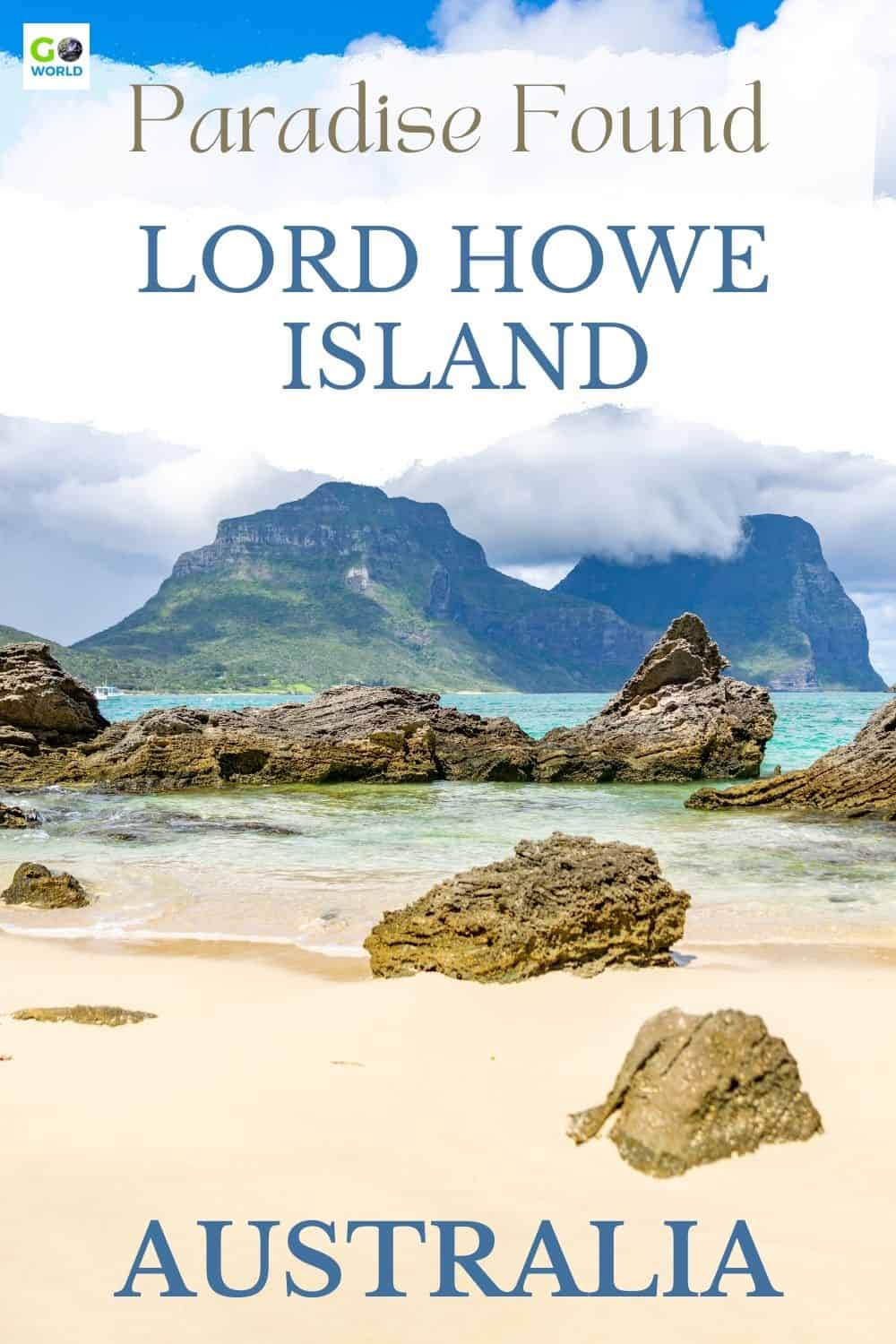
Explore the Island by Bike
The island’s small size also lends to its sustainability. You don’t need a car in a place this small so biking is the most popular mode of commute. It creates a different yet enriching experience for tourists, who have been coming here in large numbers since the turn of the 20th century.
Today, tourists are capped at about 400 per day which is the same as the Australian island’s inhabited population. This is to ensure that this World Heritage Site does not suffer from indiscriminate tourism.
The limited number further adds to the sense of novelty of the island experience, making your Instagrams all the more enviable. The first thing I did after my lock-less check-in was to hire a bike at Wilson’s Hire Service.
Tip: Wilson’s should be your first stop on the island unless you book in advance as bikes can be in short supply particularly during the busier holiday seasons.
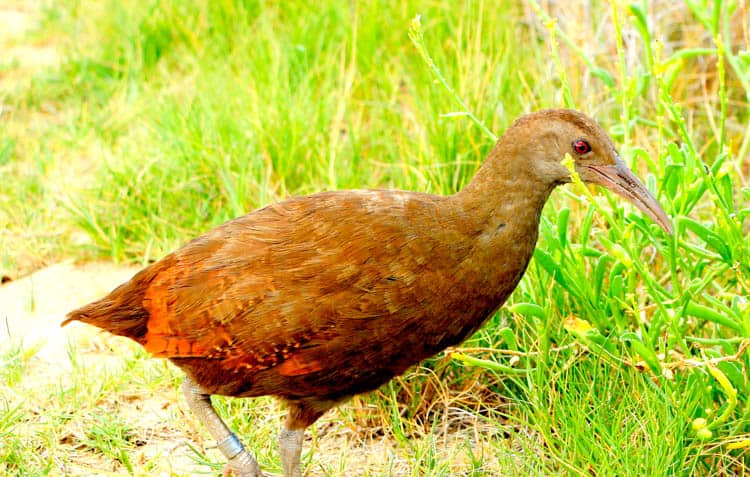
Winged Wonders
Along with a bike I also received a brief download of the island’s birdlife and its fascinating chapters in conservation. While Mr. Wilson was pumping air into my bike tyres, I watched as a couple of pristine white birds taught their fledgling how to fly.
As I kept on snapping on my Canon, Mr. Wilson came to me with my bike, speaking softly. ‘That’s a white tern – but perhaps you should be more interested in that bird over there.’
I looked to where he pointed and found a small, olive-brown flightless bird scampering away into the undergrowth. It had a metal tag on its foot as a reminder that it was part of some scientific study. Mr. Wilson explained it was the Lord Howe Woodhen, perhaps the most famous of the island’s avifauna.
Like most islands here in the Pacific, birds have evolved to become flightless in the absence of land predators while simultaneously taking on the role of ground foragers.
The kiwi, weka and the extinct Moa in New Zealand, the kagu in New Caledonia and the Lord Howe woodhen here have almost the same story of island evolution.
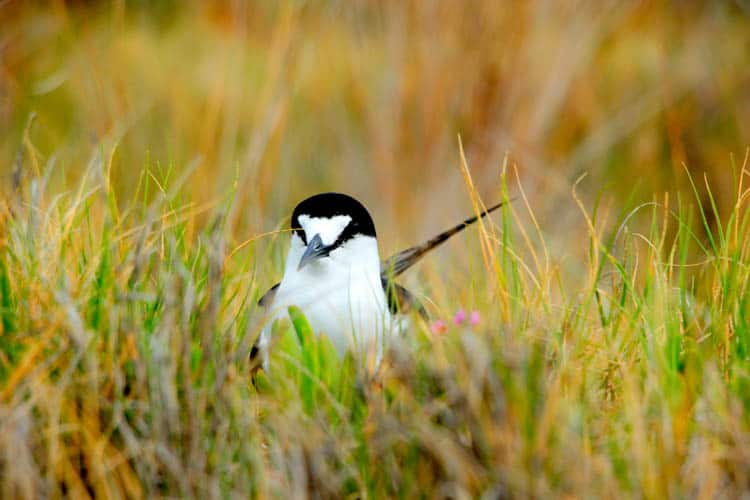
Extinction & Conservation
But as with all other places, the balance and biodiversity get disturbed with the arrival of man. Bringing in stowaway rats, while introducing cats, pigs, foxes, stoats and weasels ushers large-scale decimation on birds that have forgotten to defend themselves in the face of predators.
For LHI, nine of the endemic fifteen land-birds went extinct, including the woodhen’s beautiful cousin – the white swamphen. This lovely bird was hunted and eaten to extinction by the early settlers and whalers.
The woodhen was following suit with only about 30 birds left in the 1970s in the higher altitudes of the twin hills at one end of the island.
But the island woke up in the nick of time and a strong conservation program was introduced. The program removed all introduced predators of the woodhen, particularly the feral pigs.
The last woodhens were rounded up and fiercely guarded. After over three decades of conservation and breeding efforts, LHI is a proud sanctuary to over 400 of these woodhens, now poster children of island conservation.
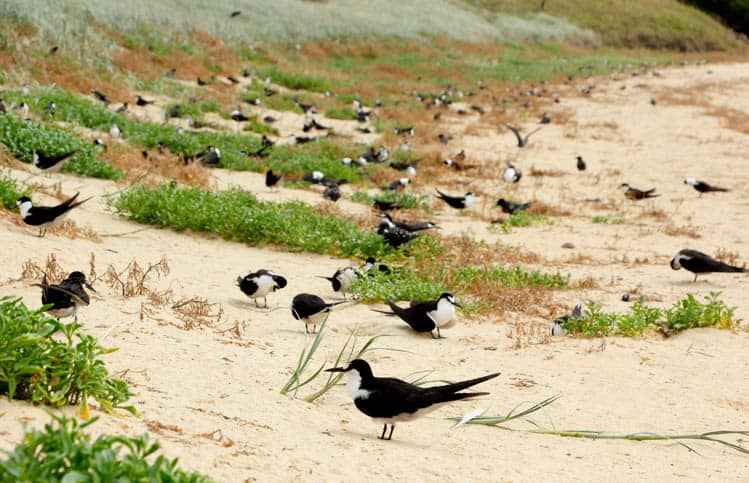
Migratory Birdlife
Considered one of the richest bird-watching hotspots of Australia, the island also has a rich share of migratory birds coming in to breed at various times of the year.
This includes the Flesh-footed Shearwaters, Sooty Terns, Red-tailed Tropic Birds, Masked Booby, Storm Petrels and Little Shearwaters.
The Sooty Terns are the most common birds here. They nest fearlessly in the hundreds on the beaches of the island. At Ned’s beach, it was with great difficulty that I restrained my three-year-old from running after these friendly birds. The same story at Blinky’s Beach reiterated the faunal richness of the island.
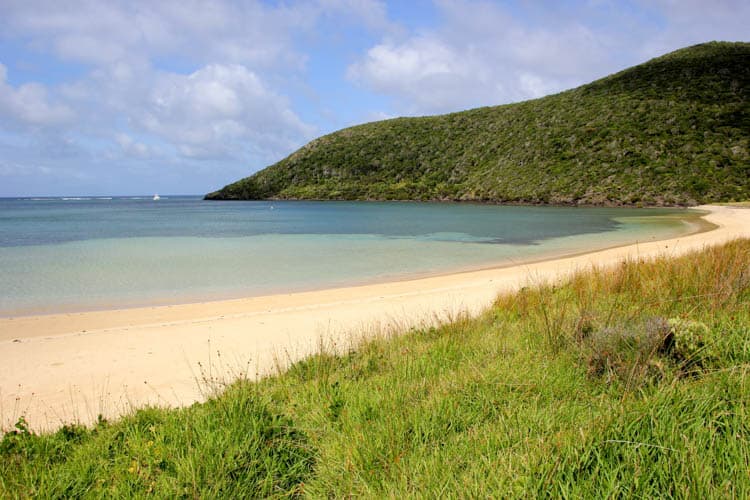
This Island’s Made for Walking
Biking is the easiest mode of commute here, bringing back those childhood adrenaline glees of speeding downhill – such as near the lagoon or near Ned’s Beach. That said, I feel more like a walker.
In the age of instantaneousness, the slow, steady pace of walking seems to calm me down. It also provides more time to look around carefully, listen to those softer undertones and thus feel more connected to the earth. If you enjoy stretching those legs like me, Lord Howe Island will feel like a walker’s paradise.
The catalogue includes full-day walks such as the hike through cloud forests to the top of Mt. Gower (rated one of the best day walks of Australia). Along with short walks through the dense palm and ficus forests to many a splendid vantage point on the island.
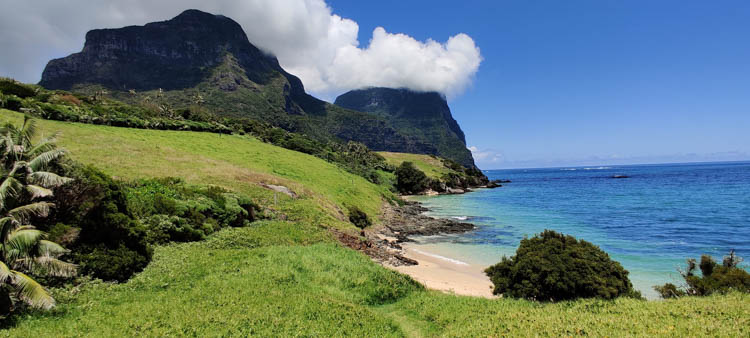
The Beautiful Malabar Hill Walk
My favourite was the walk to Malabar Hill to the north of the island. Most postcards of LHI will inevitably show you two peaks – Mt Gower and Mt Lidgbird, standing like twin sentinels at the southernmost end of the island.
If you walk on the northern side of the island, as on Malabar Hill, all your panoramic views will encompass these peaks, providing stunning shots on a sunny day.
The walk starts at a paddock near Ned’s beach and has quite a steep incline in the beginning. I kept pushing myself, my lungs wheezing in the first 10 minutes, but when I took a halt and turned back, the views justified all efforts.
The twin peaks glistened in the afternoon sky and the clear turquoise waters of the lagoon contrasted with the emerald palm forest cover on the island.
The views keep getting better the higher you go. You can easily see the two faces of Ned’s Beach with silky, white sandy on one end and pebbly black on the other. The only commonality is the terns dotted all over the beach.
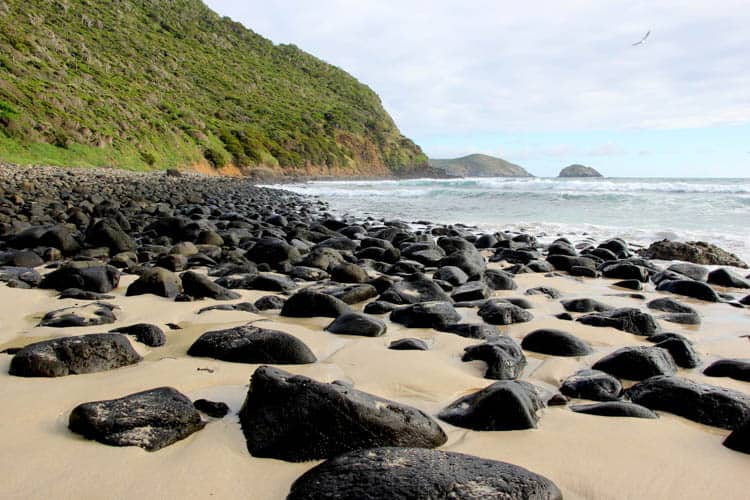
On the other side of the island lies an equally spectacular sliver of sand in the Settlement Beach. So named after the first settlers from New Zealand who established their houses close by. I kept walking up, with an occasional emerald dove or a shearwater for company, making frequent stops to turn around and look at the lagoon with its twin peaks.
The walk took about an hour to summit with grand views all around. Near the summit, a red-tailed tropicbird flew by with its noteworthy red streamer-like tail.
While I had spotted many of the other birds common to the island, this was my first time spotting a tropicbird. A reassurance perhaps that the extra mile came with a few rewards of its own.
Come October though, these cliffs will be filled with breeding pairs of these spectacular birds. The island is considered one of their largest breeding sites in the world.
After my strenuous hike, I sat down for a rest, a bit surprised that I was the only hiker in what is perhaps the island’s most popular walk. Yet, it is moments like these that make you realise how much solitude can the island offer.
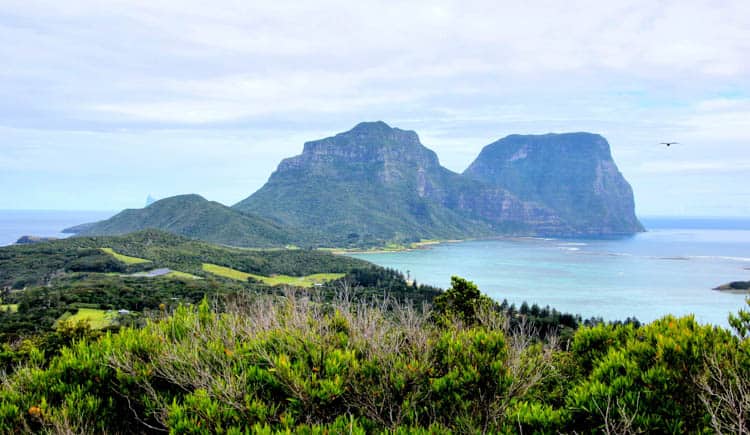
Ball’s Pyramid
I looked to the south at Gower and Lidgbird and noticed a sharp jagged triangle jutting far behind these two like the proverbial third wheel. It was the Ball’s Pyramid. A haven for deep sea-divers, named after the Navy Lieutenant who discovered LHI, Henry Lidgbird Ball.
While it may look like a thin shard, it is over a kilometre in length. Formed from volcanic activities over seven millennia ago, both LHI and Ball’s Pyramid have eroded extensively. It is said that LHI itself is less than 10% of the original volcanic island, the rest having eroded with time.
Yet the Ozymandian glory left today is worth celebrating. Ball’s pyramid itself, being the minuscule shard it is, has its own set of celebrations, holding bizarre yet distinctive records. At over 560m, it is the tallest sea stack in the world. A vertical column in the sea a la Australia’s famous twelve apostles.
Reviving the Lord Howe Island Stick Insect
It is also home to the world’s rarest insect. The Lord Howe Island stick insect is a black-coloured lobster-looking phasmid.
Once widespread on the island, it was made near-extinct by marauding rats and its use as fishing bait by humans. Thought extinct by 1920, the insect was rediscovered in 2001, surviving precariously at Ball’s Pyramid with only two dozen remaining individuals.
What followed was yet another extraordinary conservation program that saw the breeding of the rare insect at the Melbourne Zoo. Subsequently, it was also bred at other zoos around the world as insurance stocks. There are now thousands of these successfully bred phasmids with plans of reintroduction to the island as well.
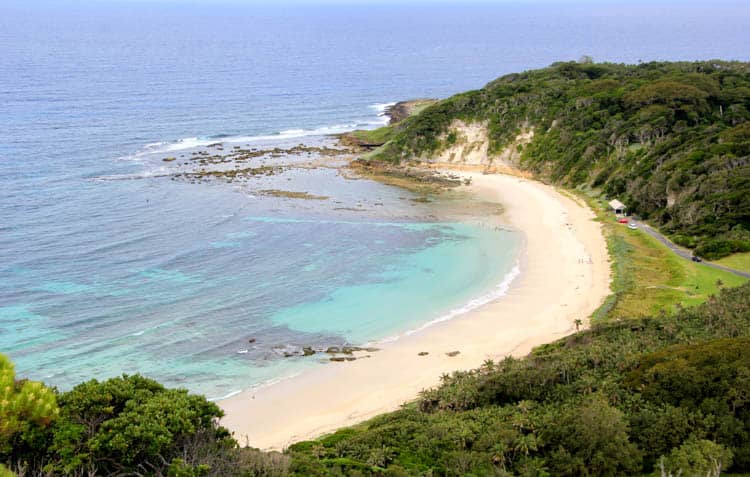
Near-Perfect Ned’s Beach
I spent almost an hour at the summit, looking philosophically at the island and bathing in a sense of tranquil timelessness. The cool winds were relaxing and balmy, whisking away all sense of stress and mentally massaging out all the knots in my head.
As the sun began to start its descent to the west, the waters looked bluer still. I took one last look at the reefs all around the island – the southern-most reef in the world – before descending quickly to join my family at Ned’s Beach.
If there is ever a prize for being an all-rounder beach, Ned’s Beach would stand first in LHI if not all

Australia. Beautiful unspoiled sands, a bird-watcher’s paradise, calm waters for that quick evening dip and full of corals within 5 metres of the beach. Throw in a few turtles, a couple of baby sharks and the fantastic fish feeding and even my three-year-old would give the sooty terns a break.
A few pellets of food and scores of mullets, wrasse and kingfish will come flocking to you in spangled colours all in Large and Extra-large sizes.
But nothing is perfect. If Ned’s Beach misses something, it is the sunset hues. The beach faces the east of the island, making it best to catch sunrises, but not sunsets.
It also made me realise that if one was to set off kayaking from Ned’s Beach, they would head straight into the absolute emptiness of the Pacific. The nearest land masses are Fiji, New Zealand or better still, Hawaii. It further made me realise how far away we had come from home.
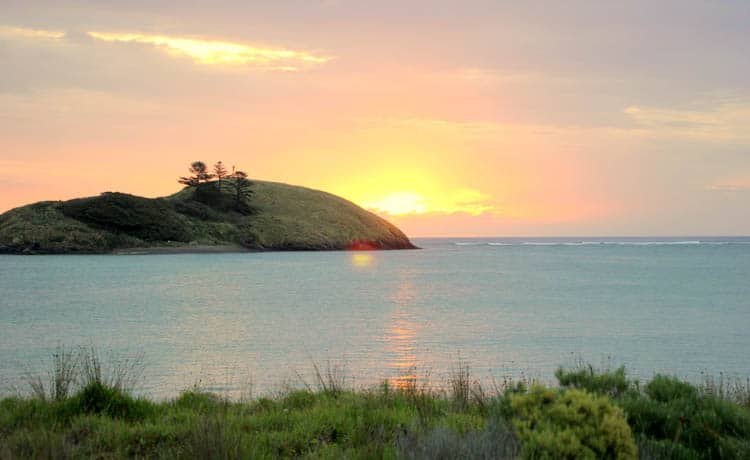
Sunset Souvenirs
The day was not yet done and we headed next to catch an immersive sunset at the lagoon. Most individuals can be classified either as ‘early waking, let’s-jog-sunrise souls’ or ‘take-a-deep-breath, let’s mellow down-sunset souls’.
However, on vacations, particularly on bejeweled islands as these, there is a universal conversion to the latter. Who can turn down an offer to sit on a grassy hill and look at the glassy blue, placid waters slowly turn to liquid gold as the alchemist sun comes down to kiss the sea?
In those few moments, lulled by the sea breeze, staring at the sparkling waters softly blitzed by a carmine sun, we seem to come closest to eternity. Moments that we will cherish forever. The experience collector that I am, I love to call these magical moments ‘sunset souvenirs’, the best gifts you can carry home.
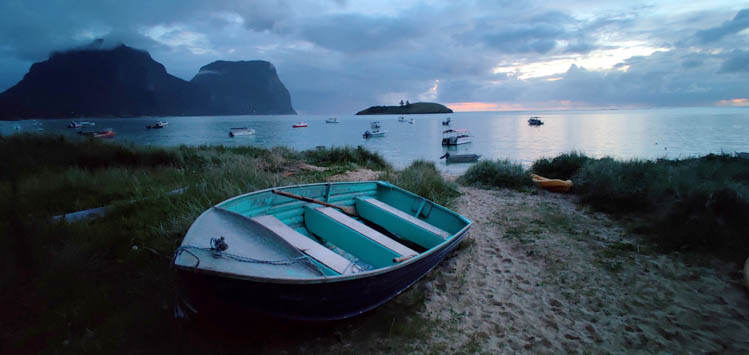
Nighttime Serenade
The sun had set but the island’s magic did not stop. The lagoon was drenched in near darkness with only a handful of soft lights from the few streetlamps when long, strange ghostly wails began to emanate from the trees.
Oo-oooo, oo-oooo, oo-ooooo it went. I guessed these were the white terns or the brown noddies in the trees. But imagine what dreary havoc these sounds might have spurred in the minds of 18th-century sailors.
The spooky serenade was not limited to the coast. Our walk back to the hotel was eerily fascinating. It was not even 8 pm but the world was all dark with only our cell phones providing light. Yet the forest was alive with the strangest symphony: wails, faraway screeches, moans and chatters began to reverberate through the trees – and through our spines.
It was an unbelievable experience. Had we not known this was the homely Lord Howe Island, with our cosy accommodation only 500m away, we would have been surely crippled with the fear of the
forest’s unknowns. I was amazed that an island this small, with that many species, could create this ensemble. The island had taken my breath away, even at night, when there was nothing to be seen.
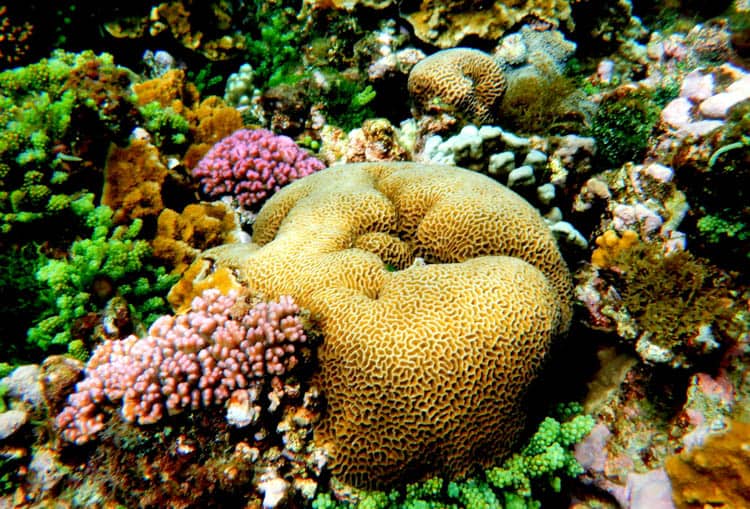
Wonders Under the Sea
One cannot celebrate an island without mermaid-ing in its waters all around. There’s plenty of opportunity at Lord Howe Island with its family-friendly lagoon and fecund reef deserving special mention.
The reef here is said to have been formed from the coral spawns of the Great Barrier Reef itself. Being part of an isolated, un-industrialized and protected Marine Park adjoining a UNESCO World Heritage Site, the richness underwater is guaranteed. There are over 80 species of corals and 500 species of fish calling this lagoon home.
We took a boat tour with Islander cruises. Their red-roofed, glass-bottomed boat ‘Islander’ stands out easily on the turquoise waters of the lagoon. A family-run business, it was started by Peter Busteed who came from Sydney on a diving holiday in 1989 and never left this paradise.
Having worked with researchers, marine biologists and scientists over three decades, Peter proved to be a font of knowledge.
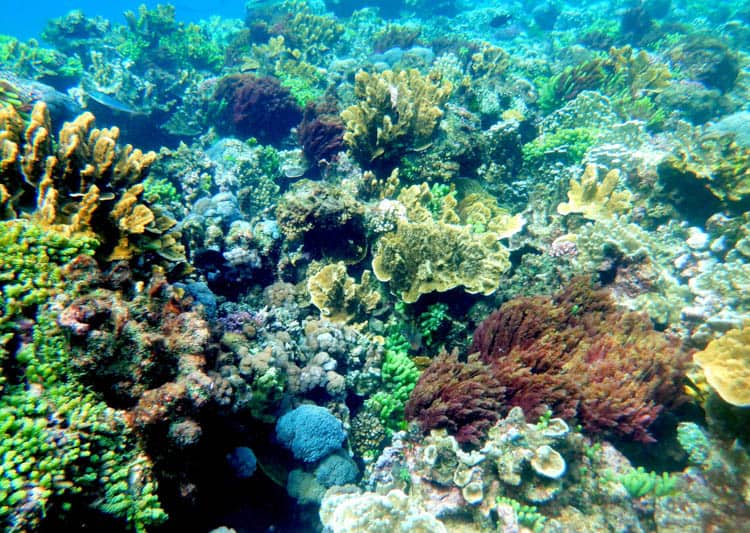
‘Lord Howe Island sits on a Goldilocks zone,’ Peter explained to an enthralled audience on the Islander as we shuttled to a shipwreck for snorkelling. ‘Similar to the Galapagos, it sits at the intersection of five ocean currents, including the warm East Australian current. Collectively these currents bring in enough warmth and nutrients for the reef to thrive.’
This explained why the reef was the southern-most reef in the world. The warm currents have helped corals survive at a latitude not normally conducive to reef growth.
At the same time, the cool currents have helped restrict damage to the reefs here, which has been minor this far, compared to the mass scale bleaching of the Great Barrier Reef.
It was a warm sunny afternoon. An almost cloudless sky was a stark antithesis to the morning that started with nimbus clouds and lashing rains. We jumped into the inviting waters near a shipwreck and got dazzled by the thriving sea-life.
There were schools of angelfish and wrasse in multiple colours and patterns. Plus trumpet-fish, parrotfish and even the anemone-fish – a black and white version of the clownfish and an LHI favourite.
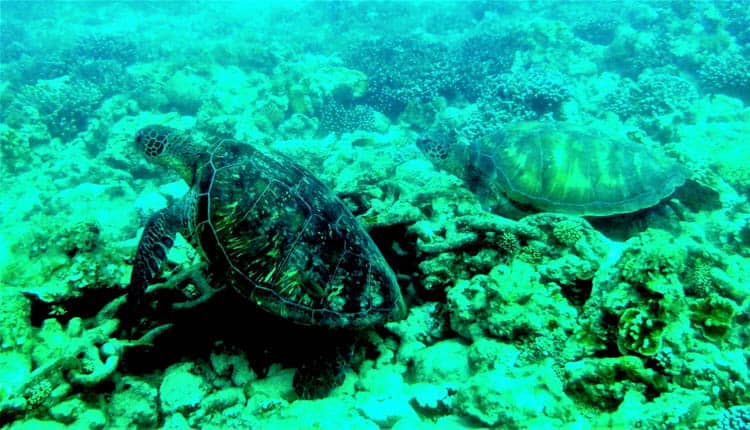
Turtle Spotting
I got back on deck after the first dive but felt a tad of jealousy when I heard others speak of an octopus around the shipwreck. But there was no time for that as we peered through the glass bottom to see large mantas and then the stars of the show that day – large green turtles.
Five of them roosted lazily on the seabed, which had apparently migrated from the islands of the Great Barrier Reef. We all made a beeline to plonk into the waters again, slowly and silently lest we disturb the languorous beasts.
It was an almost meditative experience to stay still and focus completely on the two turtles directly in front. Peter had specifically instructed us to maintain reasonable distance and create the least disturbance.
We all made a great effort to contain our excitement while snapping on our GoPros. Ten solid minutes later, the turtles moved up one by one and disappeared into the waters while we kept staring at those beautiful patterns on their carapace, rendered dream-like in the greenish water-world.
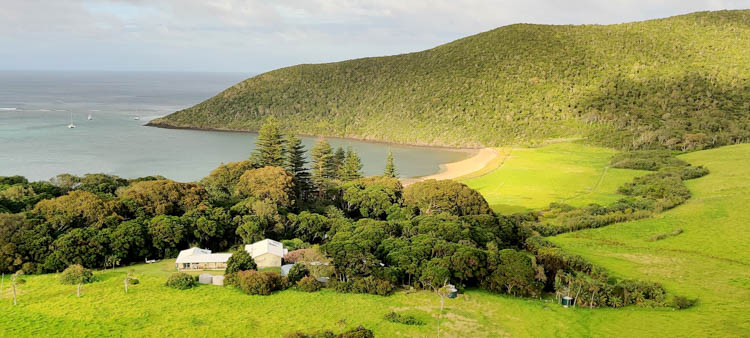
Paradise Regained
I had learned and experienced so much within these 11kms, and yet there seemed no limits to the astounding punches this island could deal. I was lucky to come here as Covid restrictions and breakouts were interrupting interstate travel within Australia.
Being part of New South Wales, LHI is still intrastate travel for visitors from Sydney. And yet, this little island is geographically in a separate continental plate called Zealandia, a submerged drowned continent discovered as recently as in 2017.
While it is more than half the size of Australia, it has mostly all been drowned. Only a few fragments of land show over water today including New Zealand, New Caledonia, Norfolk Island and Lord Howe Island.
We spent about a week on the island. Never enough, as I realised when I bumped into an old couple from Sydney celebrating a sunset near the lagoon. They had come over for a fortnight but had decided to stay for another three months.
If this was not paradise, what would be? Yes, man had decimated the island, but the conservation efforts today give us all a bit of hope. Paradise was lost, but then it is being regained bit by bit by the conscious efforts of the collective all – a mighty lesson for each of us to take back home.
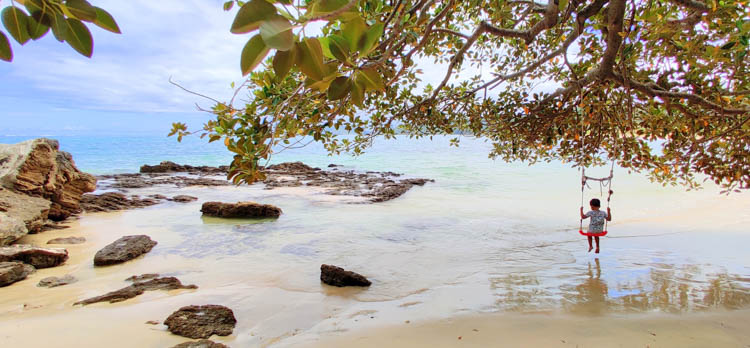
If You Go:
- Taste the delectable pea patty burger at Thompson’s General Store, running since the 1920s. Add a gelato and what better way to brunch on the lagoon just across the street!
- Bike from one end of the island near the Old Settlement Beach to the other end near the golf course – it takes less than an hour and you will end up discovering some ethereal spots such as Lover’s Bay.
- Visit the small but extremely informative Lord Howe Island Museum and learn more about the island’s history, geology and wildlife.
- Buy an endemic Kentia palm as a souvenir from the island and to support an industry that has been the island’s key revenue generator since the 1880s.
- Don’t forget to indulge in the island practice of saying a cheerful hello to every passer-by. After all, it is one very small place, but one very big family…
Book This Trip:
Ready to plan an island adventure of a lifetime to Lord Howe Island? Get prepared with hotel and vrbo accommodations, local restaurant guides, tips on how to get around and more through Travelocity and Tripadvisor.
Get the best deals on flights and ground transportation needs through CheapOair. Be sure to protect all of your planning from last minute cancellations, lost luggage or sickness with travel insurance plans catered to your needs from Squaremouth.
Author Bio: Ayan is a consultant by profession and loves traveling, and has been to nearly 30 countries. He likes writing about his travel experiences besides scribbling poetry, short stories and essays. He is currently working on a collection of haiku, and has recently published a coffee table book on the coastal beauty of New South Wales.
- Life of a Champion: Exploring the Muhammad Ali Center in Louisville - April 19, 2024
- What It’s Like to Live as an Expat: Lake Chapala, Mexico - April 18, 2024
- Top 5 Spots for Stargazing in North Carolina - April 17, 2024
